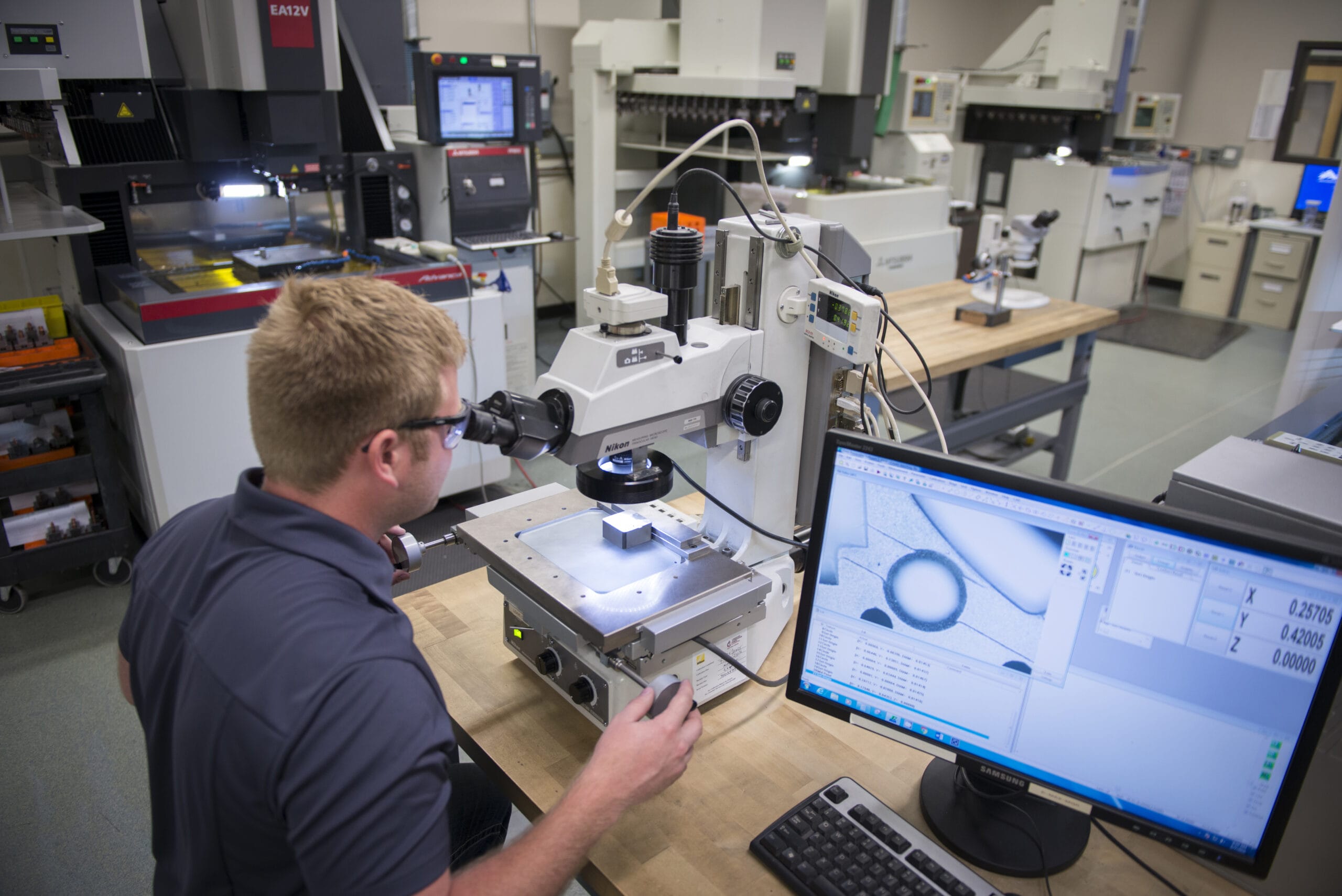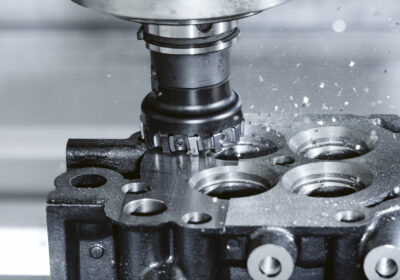Paul Runyan, VP Sales & Marketing, Accumold
The production of tiny plastic components is a multifaceted task that relies on the professional collaboration of specialists in areas such as design, material science, tool creation, micro-molding processes, quality checks, and the final assembly to achieve high-volume production for clients.
Precision is paramount in a micro manufacturing context, where the margin for error is limited to mere microns. This necessitates a laser-sharp dedication from everyone participating in the development of the product to proactively prevent any deviation from these stringent tolerances. This article explores the rigorous standards and practices that must be upheld to guarantee the desired outcomes.
Parts created through micro molding often weigh under a gram, sometimes tipping the scales at a mere 0.001 grams, with tolerances that can be as narrow as 2 microns. For producers accustomed to larger-scale injection molding, the notion of consistently fabricating such minuscule components with extreme precision might appear daunting. However, for experts in micro molding, producing these components — often for parts that are crucial for safety and demand zero defects — with virtually no margin for error is part of their everyday operations.
Additionally, it’s essential to execute these tasks not only accurately but also economically and efficiently. The key principle is to pre-empt the necessity for any redesigns, process overhauls, or the remaking of the already costly and intricate micro tools. The overarching mantra for every step is to ensure accuracy from the outset, and to get it right first time.
The cornerstone of precision in micro molding lies in the vigilant management of stages where discrepancies in exactness are most likely to arise. While opinions may differ on which parts of the product development sequence hold paramount importance in this regard, there is a strongly shared understanding that the aspect of tooling — encompassing both its design and manufacture — is essential to achieving success in micro molding projects.
MICRO TOOLING
In the area of micro tooling, experience is the foundation for achieving the minute tolerances required for success. Having a tightly integrated development cycle, where every critical stage, including design, tooling, molding, metrology, and assembly, is managed under one roof, is indispensable. The mastery over the micro molding process necessitates this vertical integration as outsourcing any segment of the design-manufacture cycle could lead to inefficiencies in time, cost, and quality control.
The key component when producing millions of products with micro-scale features is a high-quality micro tool. A subpar tool can consume your margin for error in a single stroke, jeopardizing the entire project. Therefore, it’s crucial that the tooling department possesses advanced fabrication technologies that ensure the project stays comfortably within the overall tolerance threshold, leaving room for adjustments as the product development advances.
Access to a suite of precision-enhancing technologies is essential for micro molders. The use of wire EDM (Electrical Discharge Machining) and highly precise milling equipment is often necessary. Yet, the pursuit of ultra-precision begins well before the physical creation of the tool — it starts with the synergy between tool design and fabrication experts. By collaborating closely from the outset, micro molders can secure successful results, adhering to the ethos of ultra-precision and the ethos of getting it right the very first time.

MICRO MOLDING
Upon completion of a precision-crafted and resilient micro tool, attention naturally shifts to the molding process itself. A proficient micro molder would have already played an instrumental role in shaping the design of the micro part or component to ensure it can be manufactured effectively and would have selected the most appropriate material for the job. However, when it comes to realizing the required tolerances, the molding phase is yet another stage that can trip up those without the requisite experience.
It is often said that while macro-level molding is scientific, micro-level molding combines both the science and the “art” of the craft. This notion underscores the reality that true success in micro molding hinges on the molder’s ability to innovate and apply creative problem-solving to each unique challenge.
But what does this mean in practice? The complexities of micro molding transcend the simplicity of executing pre-set instructions. It’s not a matter of scaling down macro processes; it’s about adapting and improvising with the equipment and technology available, sometimes even customizing solutions. It involves an element of nuanced, insightful experimentation to fine-tune the many variables in play.
These variables, including factors like the time the plastic spends inside the machine (residence time), the force used to inject the plastic into the mold (injection pressure), and the temperature of the mold itself, are all meticulously adjusted by the experienced micro molder to tailor the process to the material’s characteristics and the intricacies of the component’s design, thus maintaining control over the precision of the final product.
This intricate balancing act again highlights the significance of micro tooling in maintaining tolerances. No matter how many adjustments and calibrations a micro molder makes during the molding process, the outcome relies on the injection of high-pressure molten plastic into an exceedingly small and sometimes delicate cavity, which is dependent on the quality of the micro tool. If the tool can’t withstand the process — if it deflects or fractures — then all the molder’s skill and knowledge go to waste.

METROLOGY & VALIDATION
Next, we address what some may term a “necessary evil,” which, in the context of micro molding, is actually a critical component, the metrology phase. In such precise manufacturing processes, metrology becomes not just significant, but a critical enabling technology.
The role of metrology in the development of micro molded products cannot be overstated. Utilizing advanced measurement technologies capable of validating the often tiny features on end products is essential. Without such capabilities, it’s impossible to guarantee that a product matches the original design intent and is suitable for its intended use.
The saying “what can’t be measured, can’t be made” holds a dual meaning. Possessing advanced metrology tools that can measure features previously unquantifiable not only enables validation but also expands the possibilities of what can be manufactured. As such, it’s imperative for micro molders to have access to the latest metrology equipment and to follow meticulous measurement practices.
Even with state-of-the-art tools, inherent variations within any measurement system must be recognized and managed. In micro molding, establishing trust in the precision and dependability of the measurement system is crucial. Equipment variation (repeatability) and observer variation (reproducibility) are the primary concerns. Minimizing these variations provides greater confidence in the ability to detect deviations in the product’s fabrication.
Regular assessment of the measurement system, particularly Gage R&R (Repeatability and Reproducibility), should be a core aspect of ongoing refinement processes, more so in micro molding where the smallest variation can significantly impact the tight tolerance thresholds. Such evaluations fortify confidence in the instruments, operators, and methodologies. Understanding the nuances of measurement variation is essential to grasp the full scope of the manufacturing process, to better predict its capabilities, and to consistently deliver a product that meets customer expectations.
In summary, successful micro molding entities invest in superior metrology equipment and are relentlessly dedicated to enhancing their R&R metrics.
CONCLUSION
A successful micro molding project requires meticulous oversight across all phases of product development. While the focal points of this discussion have been on the crucial areas where tolerances are most stringent — such as tooling precision, molding finesse, and rigorous metrology — there are numerous other elements that demand vigilant management. Variations in the materials chosen for the micro parts can significantly influence the outcome, with even different batches potentially leading to inconsistencies in the molding process. Additionally, environmental factors, including humidity and temperature, play a subtle yet impactful role in the dimensional stability of the final products. These factors may not always take center stage, but they are influential when micro molding, each capable of reshaping the outcome if not considered.
Everything circles back to a singular, inescapable truth — the experience and integrated operations of a micro molder are not merely beneficial but essential for success. An experienced micro molder possesses the nuanced understanding necessary to navigate multifaceted challenges, leveraging a comprehensive, coordinated “under-one-roof” in- approach to ensure every step is optimized to achieve the end goal. This vertical integration isn’t just about having all the tools and processes under one roof, it’s about creating a cohesive and synergistic workflow where expertise, precision, and adaptability coalesce. When micro molding, where every micron counts, this harmonized pulling together of skills and resources is the key to unlocking consistent, high-quality production that stands the test of market demands and customer expectations.







